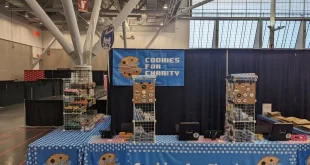Stop me if I’ve told you this story of my youth before…
Growing up I spent a number of Friday night’s at the local pizza place. Although it was officially known as “King Pizza,” everyone in my town referred to it as “Uncle Larry’s” because Larry owned it and Larry was an incredibly nice man (plus, he made a mean pizza). The place was divided in two, with a restaurant in the back and a pizza parlor up front. While my friends and I occasionally ate in the back, more often than not, we’d grab a couple of slices and sit in one of the booths up front. It was easier, faster, and less expensive that way. Plus, you could chat with Uncle Larry and you could sink a virtually endless number of quarters into the NeoGeo arcade cabinet he had there.
Uncle Larry had the four game arcade cabinet, and quite honestly I couldn’t tell you what any of the titles in it were save for Samurai Shodown. While waiting for a slice (or two) of pepperoni, a friend and I would put quarter after quarter after quarter into the machine, each trying to get the best of the other. While I would like to tell you that more often than not I came out on top, I think we were actually quite evenly matched (probably because we were equally good—or bad—at button-mashing).
The original Samurai Shodown has gone on to spur an entire franchise, and now the original is available on your PS3 via the PlayStation Network in the newly launched “NeoGeo Station.” As you may have suspected, “NeoGeo Station” is what SNK Playmore is calling the NeoGeo group of titles on the PSN (although who wouldn’t love a new NeoGeo system?). The titles are also getting a release on the PSP via the PlayStation Store.
Samurai Shodown is nothing more or less than a two-person, two dimensional fighter. It operates in the exact same manner as a Street Fighter, Mortal Kombat, or Tekken title. Stop, wait, just relax for a second – yes, I understand that all those titles have differences from one another and feature their own particular quirks, but the point of them all is to bash the other guy enough times so that they can’t get up again. In Shodown, you have got a life bar running at the top of the screen, there’s a timer counting down to the end of the round, and you have to beat the guy twice in order to take on someone new.
The game seems to be completely intact from the old arcade version, with 12 fighters, great music, and the ability to knock away your opponent’s weapon (something it was well-known for at the time). There are even some breakable items on the various levels, though nowhere near as much as what you see today in a fighter. The graphics haven’t been tweaked either, and show 4:3 with a background picture extending past the edges on a 16:9 television. The game’s instructions are also original, so it may take some time for you to figure out (or remember once you do initially learn) exactly what button as described in the game translates to what button on your controller.
Perhaps one of the greatest things about Shodown as a fighter is the POW meter (or “rage gauge”) down at the bottom of the screen. The meter fills as you take damage in a battle, and once full gives you a little extra burst of angry to help you hurt opponents. If you’re an expert at the game taking on a newbie you probably won’t like it all that much as it really helps level the playing field, but if you’re a button-masher it’s a nice little bonus for when you’re near death.
At the time I first played Samurai Shodown in Uncle Larry’s, I found the speed of the title rather remarkable – the warriors were fast and battles unfolded very quickly. In today’s day and age, while the speed of the game hasn’t slowed, other titles do seem to have caught up with it, because it no longer feels all that quick. It isn’t slow, it’s just not fast.
What Samurai Shodown still is, though, is fun. There are combos, but fewer than in a modern fighter. There are breakable things and weird little features, but compared to many of today’s fighters, it’s all very straightforward and simple. The game does come with the ability to play others on the PSN remotely, but we were unable to find anyone online to test our skills against (which, if we’re being honest, probably saved us a whole lot of embarrassment). What really breaks my heart about it though is the fact that Uncle Larry shuttered his doors a number of years back and to this day when I play Samurai Shodown I find myself with a hankering for one of his Sicilian slices.
Samurai Shodown is rated T (Teen) by the ESRB for Animated Blood, Crude Humor, Violence. This game can also be found on: Wii and PSP.
 Blogcritics The critical lens on today's culture & entertainment
Blogcritics The critical lens on today's culture & entertainment


